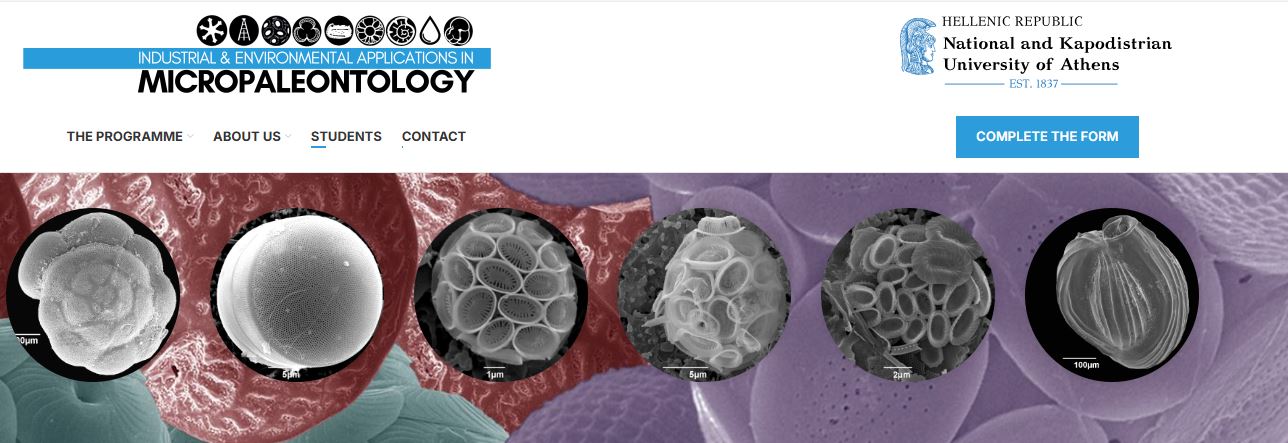A long-term research effort and goal is a better understanding of the Cenomanian stage of the Cretaceous period. The Cenomanian stage (93.9 - 100.5 mybp) is a particularly interesting time period which includes points when Earth's temperature and sea-levels were at their very highest. It is thought that sea-levels could have been as much as 200 metres higher than they are at the present day and annual mean surface temperatures 10-14 degrees higher than today. Two very significant oceanographic events occur at the beginning and the end of the Cenomanian that are also relatively rare in Earth's long history. These are called Oceanic Anoxic Events (OAEs) and represent significant periods of geological time where the worlds seas and oceans were significantly reduced in the amount of dissolved oxygen in the water. This, generally, was not favourable to life in the waters (although a few fossil groups seem to have thrived) and many marine organisms became extinct, or at least had their distribution considerably restricted.
Scroll down to the bottom of this page to see a table containing links to download our individual published papers.
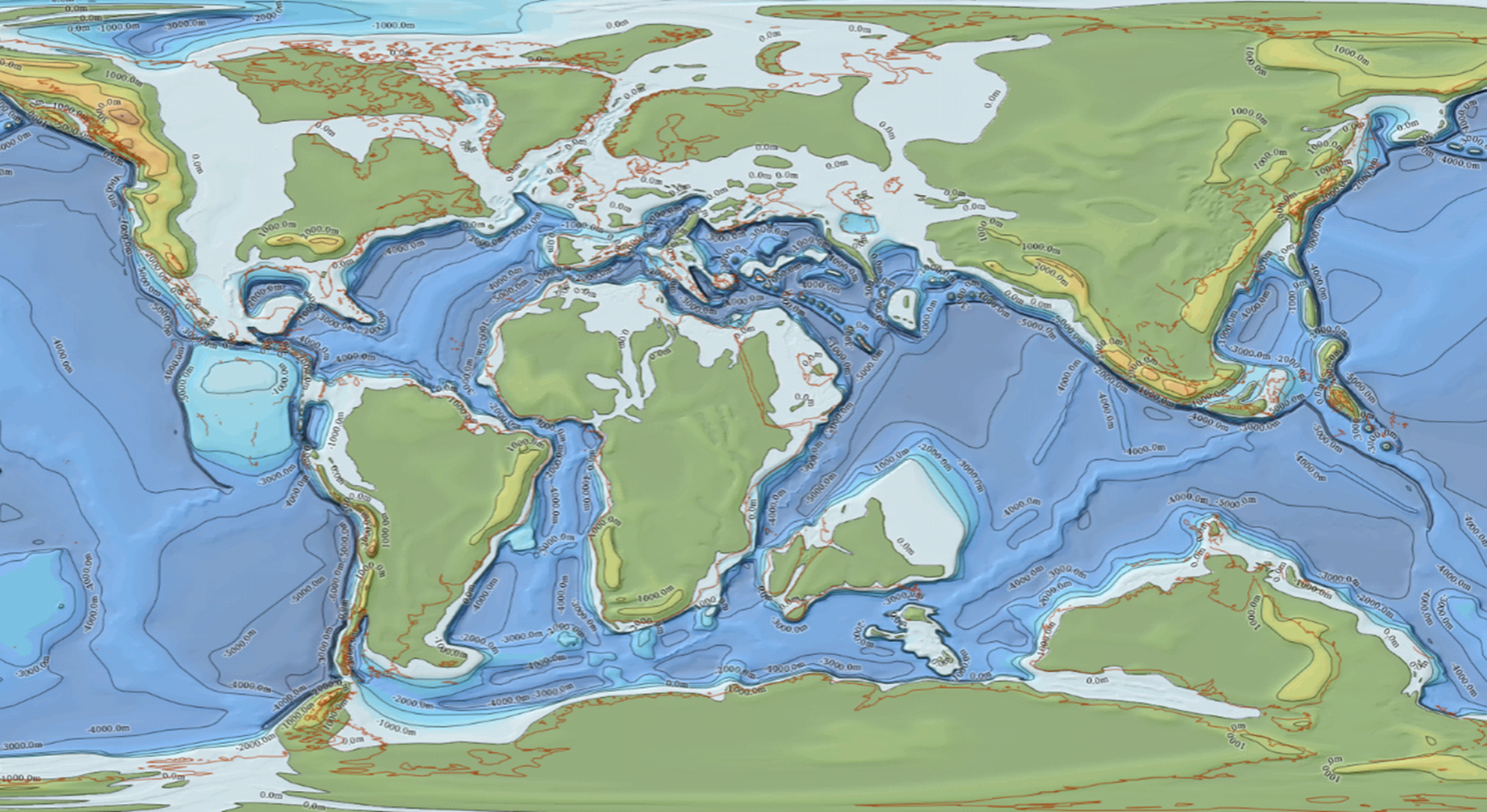 The position of the continents during Cenomanian times. High global temperatures have caused the melting of the polar ice-caps causing many areas of the continents to be flooded (light blue colour - note most of southern Europe, north Africa, the Arabian peninsula and the midwest of North America is flooded) and here, in tropical/subtropical zones, huge volumes of carbonate rocks (limestones) are deposited. The ocean between North Africa/India and Europe-Asia is called Neotethys. Previously a huge, wide ocean, it is currently (in Cenomanian times) shrinking due to the Atlantic Ocean opening and Africa rotating and (with India) moving northwards. Note that the present day Zagros Mountains (of southern and western Iran) is actually on the northeastern margin of the (Saudi) Arabian plate on the southern side of the ocean at this time but will "join" with its (Asian) Iranian counterpart just after the end of the Cenomanian. Closure of Neotethys along this junction will seal-off the (present-day) Mediterranean from the Indian Ocean, and precipitate large-scale stratigraphic re-organisation in the region. Image courtesy of the Halliburton Products Suite.
The position of the continents during Cenomanian times. High global temperatures have caused the melting of the polar ice-caps causing many areas of the continents to be flooded (light blue colour - note most of southern Europe, north Africa, the Arabian peninsula and the midwest of North America is flooded) and here, in tropical/subtropical zones, huge volumes of carbonate rocks (limestones) are deposited. The ocean between North Africa/India and Europe-Asia is called Neotethys. Previously a huge, wide ocean, it is currently (in Cenomanian times) shrinking due to the Atlantic Ocean opening and Africa rotating and (with India) moving northwards. Note that the present day Zagros Mountains (of southern and western Iran) is actually on the northeastern margin of the (Saudi) Arabian plate on the southern side of the ocean at this time but will "join" with its (Asian) Iranian counterpart just after the end of the Cenomanian. Closure of Neotethys along this junction will seal-off the (present-day) Mediterranean from the Indian Ocean, and precipitate large-scale stratigraphic re-organisation in the region. Image courtesy of the Halliburton Products Suite.
Since 2021, the research efforts of Mike Bidgood and Mike Simmons have been targeting the biostratigraphic calibration of Cenomanian rocks as, without more precise calibration, it is difficult to demonstrate the synchronicity of geological events in Neotethys and surrounding areas.
A recent study of ours (Simmons et al., 2024) looked at the major tectono-stratigraphic boundary that formed in the early Turonian, caused by the closure of Neotethys along the Zagros suture (see image above).This major sequence boundary, called the 'K150 SB' or the 'mid-Turonian Unconformity', was a major global event which caused a significant re-organisation of deposition in the central Neotethys area encompassing the Middle East region, and eroded the older Cenomanian strata down to various stratigraphic levels. Our re-calibration of 'standard' and 'local' biostratigraphic zones (including a major re-evaluation of ammonite biostratigraphy) and a comprehensive evaluation of the published biostratigraphy of individual sections, enabled us to demonstrate synchronicity of this event and to refine the timing of the event to the early part of the middle Turonian substage.
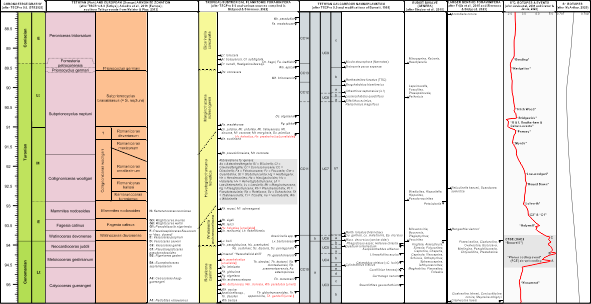

Biozonation calibration charts for the Turonian from Simmons et al. (2024). Left - multi-group synthesis, Right - ammonite zones. Click on image for a larger version.
Cenomanian Biostratigraphy
The above work on the early-middle Turonian was dependent upon a consistently-applied, well-calibrated biostratigraphic zonation. Such schemes are subject to constant revision and updates, based on the appearance of new data, particularly from regions which were historically under-studied. The Cenomanian stage is a good example of such a time interval, particularly for some fossil groups whose biostratigraphic potential has not been fully realised, or was in need of revision.
In 2022 (Bidgood & Simmons, 2022) we revised the biostratigraphy of Cenomanian planktonic foraminifera - a very important fossil group used in global biostratigraphy from the Jurassic to the present. In the same year we comprehensively revised the taxonomy and biostratigraphy of a single species of 'Larger' Benthic Foraminifera (LBF; Hemicyclammina whitei; Simmons & Bidgood, 2022). We expanded this study to include a small-ish subgroup of Cenomanian LBF (Simmons & Bidgood, 2023) and found that most taxa had either been incorrectly identified and/or incorrectly age-calibrated. We quickly realised the LBF group as a whole was in need of similar revision (the last review was published 40 years ago in 1985 with much new data published since then, including almost treble the number of species identified since 1985) and set-out a large-scale project which would tackle one sub-group (usually based around family or superfamily level) at a time.
Joining us for this major study are two world-renowned experts in Neotethyan LBF - Dr Lorenzo Consorti of the Institute for Marine Studies (CNR-ISMAR) in Trieste and Dr Felix Schlagintweit of Munich. Felix had already co-authored a paper with us on one specific genus of Cenomanian LBF (Bidgood et al., 2024).
Our first joint paper in what will be a 7-part series was published in 2024 (the Nezzazatoids) and the second (the Loftusiids) earlier this year (Simmons et al., 2024 & 2025). The third and fourth are expected to be published later in 2025 with the remainder following in 2026. It is hoped that after the publication of the final part, a single-volume work amalgamating all seven parts may be published.
Our published works are tabulated below and can be downloaded by clicking on the links. Work "in progress" is also shown and will be converted to downloadable links as soon as they are published.
WHAT IS BIOSTRATIGRAPHY AND WHY DO WE DO IT?
The rocks at the Earth's surface, and beneath our feet - the "subsurface" - can be characterised and organised based not just on the type of rock they are, but also on the fossils they contain (where the two parts; "bio-" and "-stratigraphy" come from). By analysing the fossils in the rock we can estimate the rock's age and also we can also discover something about the environment in which the sediments that make up that rock were laid down. The fossils that biostratigraphers use to do this can range in size from huge sauropod skeletons, tens of metres in size, right down to an individual grain of pollen, invisible to the naked eye.
We know that some fossil species existed for several million years before they became extinct and that other species may have existed only for a few hundreds of thousands of years during Earth's long and varied history. If we find these fossil species in our rocks we can often date those rocks to within fairly precise time ranges. More importantly, if we find that same fossil species at two or more different localities on Earth, we can correlate (join) those occurrences and begin to drawn up maps of the subsurface because we can "join the dots" between our fossil species occurrences and link together rocks that might be far apart but that were deposited at the same time.

|
These correlations are useful because we often need to know how the rocks beneath our feet are arranged. We may, for example, want to build a dam or a bridge and we need to know if the foundation rocks beneath the soil are hard and stable, or soft and crumbly. We may want to know if an offshore wind-farm can be sited in a suitable area for similar reasons. And yes, even in these days where we are trying to reduce our dependency of fossil fuels, we still need to know the best places for siting the positions of new oil and gas wells and how to produce hydrocarbons with a lower carbon footprint than we have done before. Biostratigraphy is a critical tool in our toolbox needed to understand the subsurface. Biostratigraphy revolves around the knowledge of fossils. Because many of the rock samples biostratigraphers analyse are relatively small, or come from drilled boreholes where much of the rock is smashed up into very small fragments, the fossils many biostratigraphers work with are also small - so small in fact that we have to use microscopes to see them. |
These "microfossils" come from a large variety of animal and plant origins which make up a microscopic world of their own and which often passes us by, unnoticed. Many species of microfossils are living today - two or three groups are hugely important to life on Earth today and in the geological past, as they provide most of Earth's breathable oxygen. Many others are from organisms that occupy relatively low places in the "food web" and are vital for the existence of larger animals that feed on them. Some microfossil groups come from types of organisms that are now extinct on Earth, including one form of microfossil that is believed to be mouth parts of an extinct eel-like creature that was one of our oldest ancestors!

All these microfossils are less than 1mm in size and, in the case of the nannoplankton and pollen, less than 0.01mm
EVOLUTION MAKES IT WORK!
The reason there are so many different forms of life on Earth - and the reason we have many microfossil groups and species that have lived and died throughout Earth's history - is because of evolution. Paleontologists noted long ago that many fossils they found in rocks didn't look anything like the animals (and plants) that live on Earth today, whereas some looked remarkably similar! Most people thought that the unfamiliar fossils were wiped out during the biblical flood ("Noah's flood"), while the familiar fossils survived, because they could not imagine an Earth that was older than just a few thousand years and could not imagine events which occurred before those mentioned in the bible.
A Scottish gentleman and geologist, James Hutton - himself a religious man - realised from looking at the arrangement of some of the rocks in Scotland that there must have been vastly long time-periods involved in order to arrange the rocks in the configurations we see in the present day. He presumed that the age of the Earth should be measured in millions of years (and even hundreds of millions of years) rather than just a few thousand as the bible suggested. You can see some of Hutton's rocks and watch a video of Hutton and his story on our website's front page.
| About 30 years after James Hutton's time a young naturalist from Shrewsbury called Charles Darwin set sail on a five-year voyage around the world which would show - among other things - that members of species were not all absolutely identical and that, in some cases, species would look slightly different if they could be observed in different places, say, on different islands. Darwin wondered why they were different and concluded that different features on the different islands favoured the development of certain characteristics in the animals and plants living on them. |

|
For example, tortoises with long necks were good at feeding on leaves from bushes of medium height off the ground, whereas tortoises with shorter necks fed on leaves and grass closer to the ground. The vegetation, in turn, depended on how well watered each island was. Darwin wondered if animals could adapt to the different environments each island had to offer. If they did, did they consciously change to suit the conditions or was it something they had no conscious control over? How long did it take to change? What happened to those that couldn't or didn't change?

|
|
Darwin eventually concluded that those individuals that were slightly different from their fellows - say, an individual with a slightly longer neck - would have a slightly better chance of surviving during dry periods when ground vegetation disappeared and only bush-like cactuses would grow. If an individual survived the drought, it would pass on that trait of having a slightly longer neck to its offspring who would, in turn, have a slightly better chance of surviving the next drought and passing on their long-necked trait, and so on... Darwin worked out that these small incremental changes must take place over very long time-spans in order for them to make a difference to survival and to create a brand new species of long-necked tortoise; time-spans far longer than than the two or three thousand years the biblical flood would allow. James Hutton's theories - and those that followed him - on the age of the Earth, gave Darwin the time he needed to allow for his changes (which he called "Natural Selection") to take place. |
Of course, we now know these small variations between individuals of the same species are caused by mutations in the organism's DNA and variations caused by the "mixing" of DNA between the parents. If favourable, these mutations or differences (like a slightly longer neck) could be passed on to the organism's offspring. Darwin knew about the principles of inheritance of certain characteristics from the organism's parents (including us!) but he did not know of the mutation mechanism. Nevertheless his conclusions were revolutionary and he has become one of the most influential humans in history.
Small changes, but operating over millions of years, have resulted in the diversity of life we see on Earth today, and during the geological past. It also gives us our grand mosaic of a huge variety of different species that lived during a huge variety of different time periods. It is this vast reservoir of fossil species that allows the biostratigrapher to operate.
Want to find out more? We run short training courses on how Biostratigraphy can be applied throughout many practical situations. Click here to see the Supplementary Notes that accompany our training courses. These are of a much more technical nature.
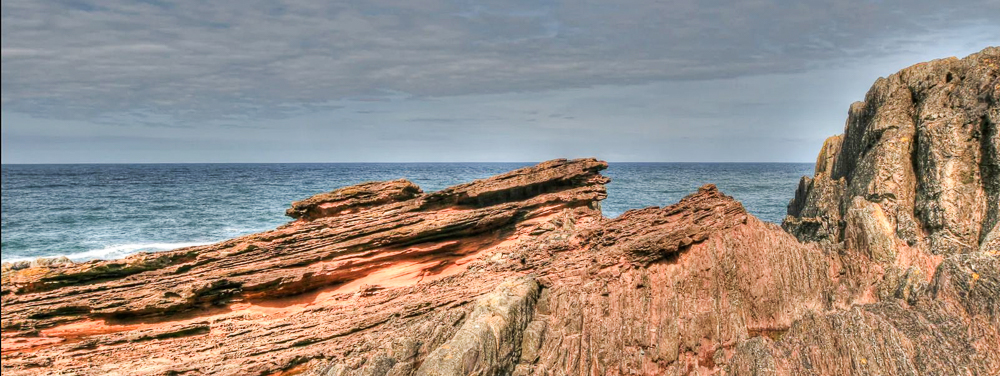
Welcome to GSS Geoscience Ltd.
GSS Geoscience Ltd. and its forerunner GSS International, formed in October 1993, has been serving the international energy industry for 32 years as an independent company!
The main image shows "Hutton's Unconformity" at Siccar Point, eastern Scotland - one of the fundamental pillars on which modern Geoscience is based. Slightly tilted reddish Devonian rocks (left) lie above almost vertical grey older Silurian sediments (lower right). The surface between them represents a time-gap of 65 million years and James Hutton (a Scottish "natural philosopher" of the 18th century) instantly changed our perceptions about the age of the Earth - until then though to be around 6,000 years old - and the role time plays in geology. Hutton realised that the Silurian rocks had to have been deposited, buried, lithified, uplifted and strongly tilted (by mountain-building events similar to those that built today's Himalayan Mountains), then eroded and re-submerged before the Devonian sediments could even begin to be laid down across their eroded surface. This sequence of events couldn't possibly have occurred over such a short a time period as 6,000 years. John Playfair, a colleague who accompanied Hutton to the locality in 1788, said "The mind seemed to grow giddy by looking so far into the abyss of time." (Photo credit: John Van Hoesen)
View a short BBC film about James Hutton and his unconformity here.
Current GSS projects include continuing our active research programme on the Cenomanian and Turonian stages of the Cretaceous period. Papers on Cenomanian Larger Benthic Foraminifera have recently been published (2023-24) in Acta Palaeontologica Romaniae, following our review of Cenomanian planktonic foraminifera published in Newsletters on Stratigraphy in 2022. An expanded series of paper on Cenomanian LBF, and and even wider review of Cenomanian biostratigraphy are in progress Go to our Research page for details and to download PDFs of our latest published research.
Another Dinosaur Killer? Not exactly, but...
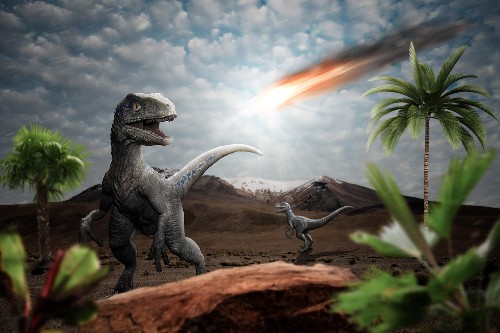
What would a geology website be without the obligatory article on dinosaurs?! There can be few people on the planet who are unaware of the sad fate of the dinosaurs who "ruled the world", brought to sudden extinction by the impact of a large asteroidal body 66 million years ago and marked the end of Cretaceous times. We now know this asteroid fell to Earth near the Yucatan Penninsula in Mexico, but for a while there was another candidate for the impact - a smaller one - having occurred in Northwest Europe. This impact crater - known as the "Silverpit" Crater - was only discovered in the early 2000s, not only because it is located beneath the waters of the North Sea, but also that it occurs almost a kilometer below the sea-bed and was detected by seismic imaging. Its basic position suggested it occurred very close to the junction between two rock series whose boundary is coincident with the Cretaceous-Tertiary extinction event. Was this the "dinosaur-killer", or at least perhaps related to it? A research paper has been published which involves GSS Geoscience's Mike Bidgood which tells the story in full, but also click here for an informal article...
A new Masters-level course in Applied Micropaleontology has been set up in Athens beginning in the Fall Semester 2025. Mike Bidgood and research associates Mike Simmons (Halliburton & the NHM), Emma Sheldon (GEUS) and Matt Wakefield (Lealt Stratigraphy Ltd.) are pleased to be associated as Advisors to the course. Applications opened in January 2025. Click the image to go to the website.
NEW PAPERS 2025!
As the year enters summer, the second in a new series of papers on Cenomanian LBF has just been published! This part concerns the "Loftusiids" and their identities and biostratigraphies are reviewed. This follows on from last year's paper on the "Nezzazatoid" group. The work is a collaborative effort between Mike Simmons & Mike Bidgood, together with Lorenzo Consorti of ISMAR-CNR, Trieste, and Felix Schlagintweit of Munich (and GSS associate) and is the second of a total of 7 anticipated future papers on this subject. A PDF of the article is now downloadable from our Research page.
We are also involved in a re-evaluation of current UK Applied Biostratigraphic training at postgraduate level, involving the GeoNetZero Centre for Doctoral Training, The Micropaleontological Society and the Geological Society of London.
Privacy and Data Collection Statement: Content on this website if for information purposes only. No data of any kind is collected from users. No cookies are used for tracking. It is not possible to register for an account on this website.

A group of NERC-CDT doctoral students interpreting the sequence stratigraphy of a well from the Gulf of Mexico.
Fortunately, in the bigger picture, none of these things are critical when it comes to understanding how biostratigraphy can help you find more energy sources. They can be left to the specialist.
However... understanding how biostratigraphy "fits" into the exploration workflow and life cycle of a precious asset is important.
We can guide you through the grey, technical "fog". We can show you why and how biostratigraphy can be applied at numerous points along the screening-exploration-development-production workflow without worrying about the identification of fossils or their strange names. Topics covered include:
- Biostratigraphy in basic-screening and exploration
- Constructing chronostratigraphic charts and gross depositional environment (GDE) maps
- Biostratigraphy in sequence stratigraphy - prediction of the subsurface and identifying new plays
- Biostratigraphy in sequence stratigraphy - identifying and characterising surfaces and systems tracts
- Biostratigraphy in appraisal
- Biostratigraphy in production - at the wellsite; monitoring, "geostopping" and "biosteering"

Mike Bidgood and Associates have also provided these courses to young people about to enter the Energy Industry at both Masters degree and Doctoral level at the following institutions: The Universities of Aberdeen (UK), Bonn (Germany), Brunei, Chulalongkorn (Bangkok, Thailand), Heriott-Watt (UK), Imperial College (UK), Manchester (UK) and Royal Holloway (UK) and in various localities for NERC-CDT (Centre for Doctoral Training). We have also provided short-courses in Applied Biostratigraphy for AAPG in London.

 |
Dr Mike Simmons is Technology Fellow for Geosciences and the Energy Transition for Halliburton Inc. at Abingdon, Oxfordshire, and a Research Fellow at the Natural History Museum in London. He is a global thought-leader on industry-related geoscience topics such as sequence stratigraphy, sea-levels; their magnitudes and timing, basin analysis, large-scale and dimensionless geoscience databases, predictions using AI & ML and, not least, the Energy Transition. Formerly 17 years with BP and subsequently at Aberdeen University and chief geoscientist at CASP, Mike was a co-founder and Director of Neftex Geological Consultants Ltd. in 2001. Ever since completing his PhD on Cretaceous shallow-water carbonates from Oman, and their biostratigraphy, Mike has always been interested in the value of different fossil groups to the integrated biostratigraphy of the Neotethyan region. |
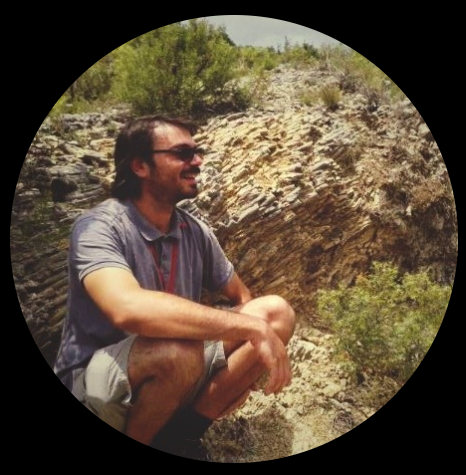 |
Dr Lorenzo Consorti is a senior research scientist at CNR-ISMAR (Institute of Marine Sciences) in Trieste, Italy. His research field is the sedimentary shallow-water successions of the Mesozoic and Cenozoic as archives of past climate change and sedimentary and biological processes. He specialises in the study of larger benthic foraminifera but has wide-ranging research interests; publishing on topics as diverse as LBF, to digital imaging of shark vertebrae all the way up to the study of past oceans and lakes on Mars! |
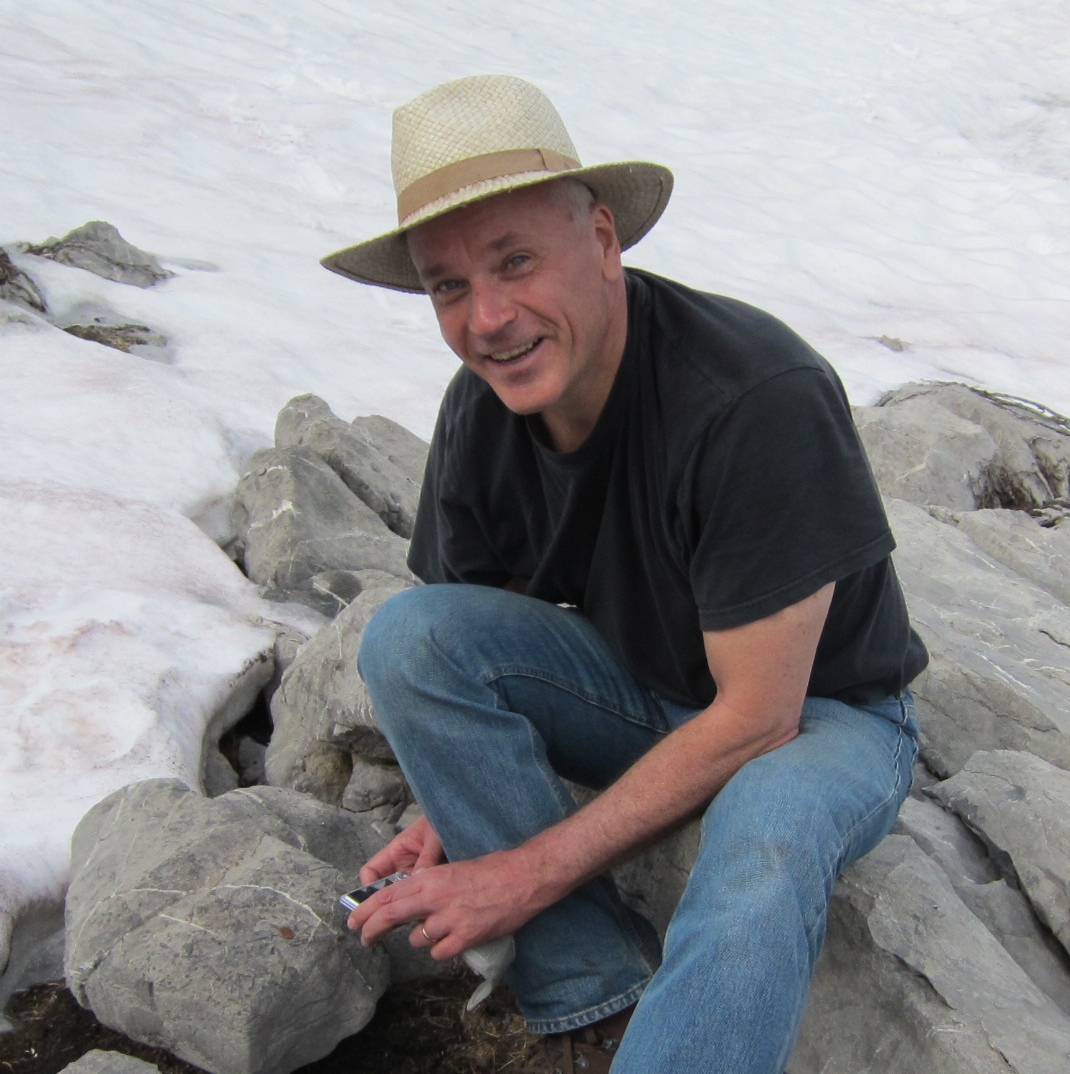 |
Dr Felix Schlagintweit is an independent researcher based in Munich, Germany. Felix has a deep interest in LBF from the Triassic to the Paleogene, and has published over 100 articles on the subject, specialising on the detailed morphology of the group and how fossil species can be identified. |
Mike B, Mike S, Lorenzo & Felix are currently focussing on the biostratigraphic aspects of the Mid Cretaceous, in particular the Cenomanian (where they have recently published reviews on the planktonic and the "larger benthic" foraminiferal biostratigraphy - the latter work part of a major effort to document and refine Cenomanian LBF biostratigraphy - and the Turonian and Coniacian stages.
Click here to go to the Cenomanian Research Projects page.
In Preparation/Press:
Simmons, M.D. & Bidgood, M.D. Cenomanian larger benthic foraminifera - a stratigraphic review. [an assessment of the validity of published data to evaluate the identity and stratigraphy of LBF recorded from Cenomanian strata - an extension paper to our 2023 review of "planispiral" forms, this data includes the assessment of over 100 species and which will be published as a series of papers covering separate taxonomic groups]
Simmons, M.D. & Bidgood, M.D. Cenomanian marine biostratigraphy: a review. [a review, comparison and integration of the stratigraphy of numerous fossil groups e.g., ammonites, inoceramids, foraminifera, nannofossils, palynomorphs, bivalves, ostracods, microcrinoids, radiolaria, together with radiometric dating, isotope curves and sea-levels]
Published:
Bidgood, M.D., 2025. The Silverpit Crater – Evidence of a Dinosaur Killer? Informal GSS article.
Bidgood, M.D., Schlagintweit, F., & Simmons, M.D. 2024. The genus Orbitolina d'Orbigny, 1850 (Larger Benthic Foraminifera) and its constituent species: notes on identity and stratigraphic ranges. Acta Palaeontologica Romaniae, 20 (2), 33-59.
Mahboubi, C.Y., Naimi, M.N., Simmons, M.D. & Bidgood, M.D., 2024. Algal microfacies in the Theniet Et Temar Formation (middle Oxfordian), Central Saharan Atlas, Algeria. Proceedings of the Geologists' Association,135 (1), 78-88.
Simmons, M.D. and Bidgood, M.D., 2022. Hemicyclammina whitei (Henson, 1948): The senior synonym of Hemicyclammina sigali Maync 1953, a distinctive larger benthonic foraminifer from the Mid-Cretaceous of Neotethys. Acta Palaeontologica Romaniae, 19 (1), 27-40.Bidgood, M.D. and Simmons, M.D., 2022. Cenomanian planktonic foraminifera, bioevents and biozonation – A brief review. Newsletters on Stratigraphy, 56 (2), (2023), 125 - 156.Okay et al., 2020. Eocene-Oligocene succession at Kıyıköy (Midye) on the Black Sea coast in Thrace. Turkish Journal of Earth Science, 29, 139-153.Simmons, M.D., Bidgood, M.D., Brenac, P. et al., 1999. Microfossils assemblages as proxies for precise palaeoenvironmental determination - an example from Miocene sediments of northwest Borneo. In: Jones, R. W. & Simmons, M. D. (eds), Biostratigraphy in Production and Development Geology. Geological Society, London, Special Publications, 152, 219-241.

